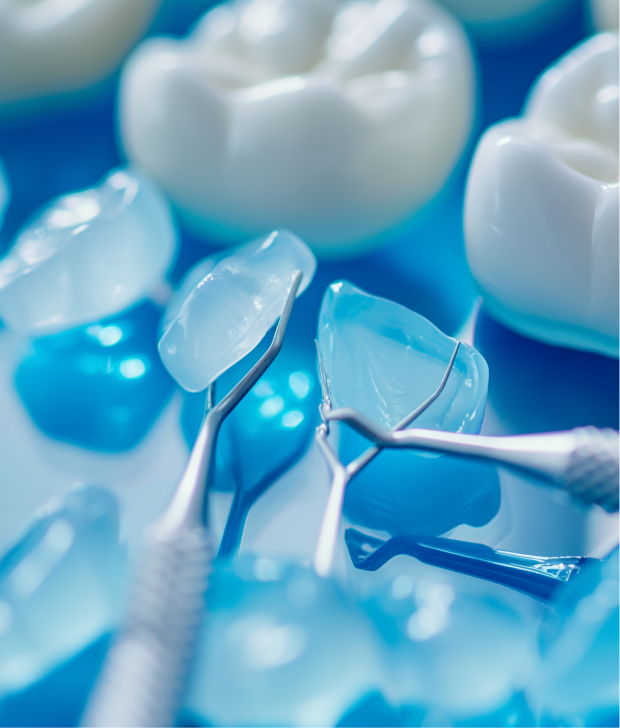

Dental Bonding: A Quick Fix for Chipped and Discolored Teeth
Learn how dental bonding can quickly fix chipped and discolored teeth in one visit at South Bay Dental Esthetics in Redondo Beach.
Dental Bonding: A Quick Fix for Chipped and Discolored Teeth
Whether you chipped a tooth during a beach volleyball game or want to fix a gap in your smile for an upcoming event, dental bonding might be the perfect solution. This popular cosmetic dental treatment can transform your smile in just one visit to South Bay Dental Esthetics, making it a favorite choice for busy Redondo Beach residents.
What Is Dental Bonding?
Dental bonding is a cosmetic procedure where tooth-colored composite resin is applied to your teeth to improve their appearance. Think of it as artistic sculpting – Dr. Bo carefully shapes and molds the material to create a natural-looking repair or enhancement.
Key characteristics of dental bonding:
- Uses tooth-colored composite resin material
- Applied directly to your existing tooth
- Hardened with a special curing light
- Shaped and polished to match surrounding teeth
- Usually completed in one appointment
Problems Dental Bonding Can Fix
Bonding is a versatile treatment that addresses many common cosmetic concerns:
Tooth Damage
- Small chips and cracks
- Minor fractures
- Worn tooth edges
- Surface scratches
- Small areas of tooth decay
Cosmetic Issues
- Discolored spots that don't respond to whitening
- Gaps between teeth
- Teeth that appear too small
- Irregularly shaped teeth
- Minor alignment issues
Functional Problems
- Exposed tooth roots from gum recession
- Worn tooth surfaces affecting bite
- Sharp tooth edges that irritate tongue
- Minor bite irregularities
The Dental Bonding Process
One of the biggest advantages of bonding is its simplicity and speed:
Initial Assessment
Dr. Bo will:
- Examine the area to be treated
- Discuss your goals and expectations
- Determine if bonding is the best solution
- Explain the process and expected results
Tooth Preparation
Minimal preparation required:
- Little to no tooth structure removal
- Usually no anesthesia needed
- Surface slightly roughened for better adhesion
- Tooth cleaned and dried thoroughly
Bonding Application
Step-by-step process:
- Conditioning liquid applied to tooth
- Tooth-colored resin carefully applied
- Material shaped and sculpted to desired form
- Multiple layers may be applied if needed
- Each layer hardened with curing light
Final Shaping and Polishing
- Final adjustments to shape and size
- Smooth blending with natural teeth
- Polishing for natural luster
- Bite adjustment if necessary
- Final inspection and approval
Total appointment time: Usually 30-60 minutes per tooth
Types of Bonding Materials
Composite Resin
Most common bonding material:
- Available in many tooth-colored shades
- Can be layered for depth and translucency
- Bonds chemically to tooth structure
- Can be repaired if damaged
Shade Matching
Dr. Bo carefully selects resin colors that:
- Match your existing teeth perfectly
- Blend seamlessly with natural enamel
- Account for translucency and depth
- Look natural in different lighting
Advantages of Dental Bonding
Speed and Convenience
- Single appointment treatment
- No laboratory work required
- No temporary restorations needed
- Perfect for busy schedules
Conservative Treatment
- Preserves maximum natural tooth structure
- Usually no anesthesia required
- Reversible procedure
- Less invasive than veneers or crowns
Affordability
- Less expensive than porcelain veneers
- More affordable than crowns
- Good value for cosmetic improvement
- Often covered by insurance for functional repairs
Versatility
- Can be used on multiple teeth
- Easily repaired if damaged
- Can be modified or added to later
- Works well for various problems
Natural Appearance
- Blends seamlessly with natural teeth
- Can be customized for perfect color match
- Reflects light like natural enamel
- Looks completely natural when done well
Caring for Bonded Teeth
With proper care, dental bonding can last 5-10 years:
Daily Care
Treat bonded teeth like natural teeth:
- Brush twice daily with fluoride toothpaste
- Floss daily around bonded areas
- Use soft-bristled toothbrush
- Avoid abrasive toothpastes
Foods and Habits to Avoid
Protect your bonding investment:
- Don't bite fingernails or pen caps
- Avoid chewing ice or hard objects
- Don't use teeth as tools
- Limit very hard foods like nuts
- Be careful with sticky candies
Staining Prevention
Keep bonding looking its best:
- Limit coffee, tea, and red wine
- Don't smoke or use tobacco
- Rinse mouth after consuming staining foods
- Consider using a straw for dark beverages
Regular Dental Care
- Professional cleanings every six months
- Regular checkups to monitor bonding
- Early repair of any chips or wear
- Professional polishing when needed
Bonding vs. Other Cosmetic Options
Bonding vs. Veneers
Choose bonding if you want:
- Single-visit treatment
- Lower cost option
- Minimal tooth preparation
- Easy repair or replacement
Choose veneers if you want:
- Maximum durability (10-15 years)
- Best stain resistance
- Multiple teeth treatment
- Most natural appearance
Bonding vs. Crowns
Bonding is better for:
- Minor cosmetic changes
- Preserving tooth structure
- Lower cost treatment
- Quick results
Crowns are better for:
- Severely damaged teeth
- Maximum strength and durability
- Major shape or size changes
- Teeth with large fillings
Who Is a Good Candidate?
Bonding works best for people who have:
- Good overall oral health
- Realistic expectations
- Minor cosmetic concerns
- Adequate tooth enamel
- Good oral hygiene habits
Conditions that might affect bonding:
- Severe teeth grinding (bruxism)
- Very poor oral hygiene
- Extensive tooth damage
- Heavy staining habits
- Unrealistic expectations
Cost Considerations
Bonding costs vary based on:
- Size and complexity of treatment
- Number of teeth involved
- Geographic location
- Dentist's experience and expertise
Insurance coverage:
- Often covered for functional repairs
- May not cover purely cosmetic treatment
- Check with your insurance provider
- Payment plans often available
Limitations of Dental Bonding
While bonding is excellent for many situations, it has some limitations:
Durability
- Not as strong as natural teeth
- May chip or break with excessive force
- Typically lasts 5-10 years
- May need periodic touch-ups
Staining
- More porous than porcelain
- Can stain over time
- Requires careful maintenance
- May need replacement if severely stained
Size Limitations
- Best for minor repairs and changes
- Not suitable for major reconstruction
- Limited by natural tooth structure
- May not work for extensive damage
When to Consider Alternatives
You might need different treatment if you have:
- Extensive tooth damage
- Multiple teeth requiring treatment
- Severe discoloration
- Major shape or size changes needed
- History of breaking bonding
The South Bay Dental Esthetics Difference
Expert technique:
- Dr. Bo's artistic eye for natural results
- Advanced composite materials
- Precise shade matching
- Attention to detail
Patient comfort:
- Relaxing office environment
- Gentle, painless procedure
- Clear communication throughout
Quality materials:
- High-grade composite resins
- Multiple shade options
- Durable, long-lasting results
- Natural translucency and texture
Maintenance and Longevity
To get the most from your bonding investment:
Immediate aftercare:
- Avoid staining foods for 48 hours
- Don't smoke after treatment
- Be gentle when chewing
- Report any rough spots immediately
Long-term care:
- Regular dental checkups
- Professional cleanings
- Early repair of small chips
- Good oral hygiene habits
Making Your Decision
Consider bonding if you:
- Want a quick, affordable solution
- Have minor cosmetic concerns
- Prefer conservative treatment
- Need same-day results
- Want to preserve natural tooth structure
Dental bonding offers an excellent way to improve your smile quickly and affordably. While it may not be the right solution for every situation, it's perfect for many common cosmetic concerns.
Interested in learning if dental bonding is right for your smile? Schedule a consultation with Dr. Bo at South Bay Dental Esthetics by calling (310) 318-5442. We'll help you determine the best treatment option for your unique needs and goals.


